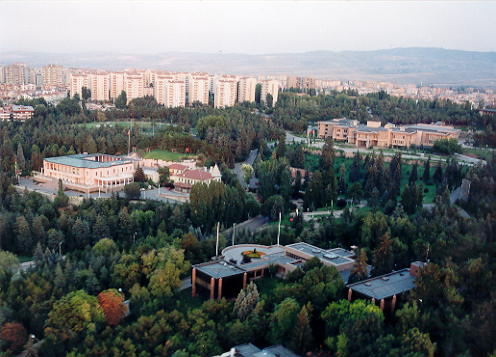- Çankaya Köşkü
Infobox Political post
post = Presidency
body =
the Republic of Turkey
insignia = Cumhurbaskanligiforsu.jpg
insigniasize = 160px
insigniacaption = The Insignia of the Presidency
incumbent =Abdullah Gül
formation =October 29 ,1923
inaugural =Mustafa Kemal Atatürk
website = [http://www.cankaya.gov.tr/eng_html/index.html Çankaya Köşkü (English)]Çankaya Köşkü is the
official residence of thePresident of Turkey . It is located in the Çankaya district ofAnkara , which lends its name to the palace. The name is sometimes used as ametonymy for the current president. The Çankaya Presidential Compound, stretches over convert|438|acre|km2 of land with its unique place in Republican Turkish history. The Çankaya compound houses Atatürk's Museum Villa, the Pink Villa, the office of the Chief Aide-de-Camp, the Glass Villa and new office buildings including the State Supervision Council, reception halls and a press conference hall. There are also sports facilities, a fire brigade, a greenhouse as well as the barracks of the Presidential Guard.The Museum Villa (Müze Köşk)
Who would have imagined that a vineyard lodge built in 1876 in the hills of Çankaya village in Ankara would witness a history and serve as a home to a world-renowned leader who would change the destiny of his nation?
After his arrival in Ankara on 27 December 1919,
Atatürk , the first President of the Republic of Turkey, lived in the Ankara School of Agriculture. After his election as the speaker of the Grand National Assembly on 23 April 1920, he moved to a stone-built house at the railway station, which used to be the Chef de Gare's lodge, known as the "Direction House". In the early days of June 1921, Atatürk settled in this vineyard lodge, which, after some minor repairs, came to be known as the "Çankaya Villa".In 1924, Architect Mehmet Vedat Bey made some renovations, including a second floor for new bedrooms, a framed window entrance in the front, a pantry and kitchen in the back, and a tower on the side. In 1926, a central heating system was added. This Villa became his home until he moved to the new premises of the Pink Villa (see below) in June 1932. The building was named 'Army House' after Atatürk transferred it to the Army. The Villa has held a very important place in the history of the Republic. In 1950, after some renovations, it was opened as a museum for public access. In 1986, major restoration works were completed. Since then, a conservation program has been implemented to preserve the Villa in its original form, with all its original fittings and furniture.
Despite having been transformed into a "villa", the building might not have enjoyed the splendour of being a palace, but it lived on as a modest and cozily decorated structure. The moment you set foot in the stone entrance, you immediately find yourself in the 1920s. The building is far from the opulence of large palaces and is unpretentious, yet styled with taste and designed for practical use. It served as Atatürk's headquarters during the War of Independence and the years of revolution. Having witnessed to a number of defining moments at a time when the War of Independence was fought and the Republic was founded, today, it is preserved with utmost care as part of Atatürk's indelible memory.
The Pink Villa (Pembe Köşk, or Çankaya Köşkü)
In 1930, the original Villa had no more room to serve the needs of the expanding functions of the Presidency. Atatürk requested the renowned Austrian architect Professor
Clemens Holzmeister be invited to design and build a new Presidential palace. Professor Holzmeister, after modifying his design in accordance with Atatürk's personal comments, completed the building in 1932, which later came to be known as the Pink Villa. A part of the Villa's interiors was designed at the Vienna Academy of Fine Arts. In concept, the Pink Villa's design was based on a traditional Turkish home, modified to serve both as a Presidential residence and an office, equipped with the amenities of a Western lifestyle. The fact that Atatürk was personally involved in its design makes it particularly significant as the Pink Villa represents his taste and style.Atatürk resided in the Pink Villa until his death in 1938. All other presidents to date resided there after him. It was only after new office buildings were completed during 9th President [Süleyman Demirel] 's term, that the Pink Villa was renovated and restored to its original design in 2001. Since then it has served only as a presidential residence.
The Glass Villa (Camlı Köşk)
Designed by Seyfi Arkan, a Turkish architect, as a single storey modern residence of mid 1930s, the Glass Villa served as a home for Atatürk's sister Makbule Atadan. After a brief period of service as an official guest house for visiting heads of states between 1951 and 1954, the Villa was used as a residence for Prime Ministers and Speakers of the Republican Senate until 1970. Through the years, the Glass Villa was extensively modified and extended, the latest having been completed in 1996. Since then, it serves again as a guest house for visiting heads of states.
External links
* [http://www.cankaya.gov.tr/tr_html/cankaya.html Official site]
Wikimedia Foundation. 2010.
